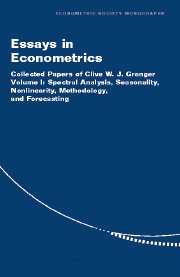Book contents
- Frontmatter
- Contents
- Acknowledgments
- List of Contributors
- Introduction
- 1 The ET Interview: Professor Clive Granger
- PART ONE SPECTRAL ANALYSIS
- PART TWO SEASONALITY
- PART THREE NONLINEARITY
- PART FOUR METHODOLOGY
- 11 Time Series Modeling and Interpretation
- 12 On the Invertibility of Time Series Models
- 13 Near Normality and Some Econometric Models
- 14 The Time Series Approach to Econometric Model Building
- 15 Comments on the Evaluation of Policy Models
- 16 Implications of Aggregation with Common Factors
- PART FIVE FORECASTING
- Index
14 - The Time Series Approach to Econometric Model Building
Published online by Cambridge University Press: 06 July 2010
- Frontmatter
- Contents
- Acknowledgments
- List of Contributors
- Introduction
- 1 The ET Interview: Professor Clive Granger
- PART ONE SPECTRAL ANALYSIS
- PART TWO SEASONALITY
- PART THREE NONLINEARITY
- PART FOUR METHODOLOGY
- 11 Time Series Modeling and Interpretation
- 12 On the Invertibility of Time Series Models
- 13 Near Normality and Some Econometric Models
- 14 The Time Series Approach to Econometric Model Building
- 15 Comments on the Evaluation of Policy Models
- 16 Implications of Aggregation with Common Factors
- PART FIVE FORECASTING
- Index
Summary
TWO PHILOSOPHIES
There are currently two distinct approaches available for the analysis of economic data measured through time: the time series approach and the classical econometric model building method. These two approaches are based on quite different philosophies about what is important and how data should be approached. It is almost a tautology to say that the optimum approach should probably involve the best features of each. The object of this paper is to outline the lessons from recent advances in time series analysis, as we see them, for econometric model building. It is accepted that the ultimate aim of econometricians is to build sound models of the economy that can then be used to check hypotheses, make good forecasts, and suggest control possibilities. However, we do feel that the present methods of model construction are far from perfect and that time series techniques can be used to improve matters.
The two basic differences in approach involve the determination of the lag structure of the model and the handling of the residuals. Further differences are concerned with the treatment of trend and seasonal components. These four features of model building are not unrelated, of course. In the time series approach to modeling a great deal of attention is paid to the lag structure of variables entering the model, whereas in most econometric models a rather ad hoc approach is taken to the introduction of lagged variables.
- Type
- Chapter
- Information
- Essays in EconometricsCollected Papers of Clive W. J. Granger, pp. 302 - 316Publisher: Cambridge University PressPrint publication year: 2001



